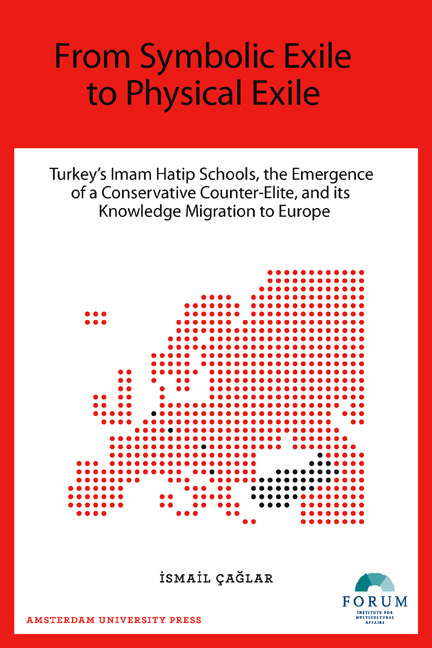 From Symbolic Exile to Physical Exile
From Symbolic Exile to Physical Exile Book contents
- Frontmatter
- Contents
- Foreword: Pious Muslims as a Bridge between Turkey and the West: The Remarkable Case of the Imam Hatip Graduates Studying in Europe
- Introduction
- 1 Historical Background
- 2 İHL Graduates in Vienna
- 3 İHL Graduates in Sarajevo
- 4 İHL Graduates in Other Countries
- Conclusion
- Notes
- Bibliography
- List of Acronyms
- Basic background Information on the Key Respondents
- Index
1 - Historical Background
Published online by Cambridge University Press: 16 February 2021
- Frontmatter
- Contents
- Foreword: Pious Muslims as a Bridge between Turkey and the West: The Remarkable Case of the Imam Hatip Graduates Studying in Europe
- Introduction
- 1 Historical Background
- 2 İHL Graduates in Vienna
- 3 İHL Graduates in Sarajevo
- 4 İHL Graduates in Other Countries
- Conclusion
- Notes
- Bibliography
- List of Acronyms
- Basic background Information on the Key Respondents
- Index
Summary
THE REPUBLICAN REFORMS: CONTINUITY OR CHANGE?
Modern Turkish historiography has widely promoted the idea that there was continuity between the reforms undertaken by the Ottoman regime in the eighteenth and nineteenth centuries, and the process of modernization pursued by the Republic in the twentieth century. The thesis is convincing in some respects, namely in the sense that the reforms of the Ottoman period – starting in the spheres of education, the judiciary, the bureaucracy, and public services – underwent a process of acceleration during the Republican period. However, it is necessary to underline the extent of the differences, as well as the similarities, between the reform movements of the Ottoman and Republican periods, particularly with respect to three dimensions of reform: those of (1) the prevalence of the reforms; (2) the comprehensiveness of the reforms; and (3) the pace of the reforms.
To start with the prevalence, Ottoman reformers did not totally abandon previous efforts to modernize; rather, these efforts were introduced as optional ‘routes’, if not trials. The dominant pattern of reform in the eighteenth and nineteenth centuries was to first try to improve existing institutions, and only then to build new ones. Even when the second approach was taken – that is, building new structures once improving the existing ones had proven to be impossible – new institutions were introduced alongside existing ones, rather than instead of them. To illustrate this: when new institutions of higher education were introduced as an alternative to the classical medrese system, which had been the sole institution from which the military and civil bureaucracies were drawn, simultaneous attempts were made to reform medrese education. Even when Ottoman reformers realized that it would be impossible to improve the medrese system, they left the institutions in place rather than abolish them (they were finally closed after the Law on the Unification of Education was passed in 1924). We can observe the same pattern in terms of military reforms. On the one hand, Ottoman reformers established new military education institutions to train a new generation of professional commanders; on the other hand, the old generation of military personnel were allowed to remain in their posts.
- Type
- Chapter
- Information
- From Symbolic Exile to Physical ExileTurkey's Imam Hatip Schools, the Emergence of a Conservative Counter-Elite, and Its Knowledge Migration to Europe, pp. 27 - 54Publisher: Amsterdam University PressPrint publication year: 2013


